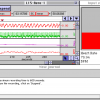SIMULATING THE CONTROL SYSTEM
- It allows simulation of various processes, such as: process steps 1 and 2, proportional operation processes (P), integral operating processes (I), dual integral operating processes ( I2).
Synthesis input to control variables (y) and noise variables (z).
Signal voltage range: -10V, …, + 10V
Coefficient of operating process rate
KP = 0.2 (attenuation) …. 1.5 (amplification)
Time constant T1 = 0.1 …. 1000 s
Time constant T2 = 0.1 …. 1000 s
Reset input to restore the original conditions
Rough setting through rotary switches
Fine installation through potentiometer
Led status indicator light
PID CONTROLS
- Standard industrial controllers can be used as P, PI, PD or PID controllers in closed-loop automatic control systems.
Aggregate inputs for two different reference variables UR and UC and for one controlled UA variable.
Signal voltage range: -10V …. + 10V
Parameter of continuous controller
Kp ratio = 0 … 1000
Time of integral operation TI = 1ms … 100 seconds
Time of derivative action TD = 0.2ms … 20 seconds
Reset input of integral controller
Aggregate output to add or remove noise variables
Gate measurement error signal
Output adjustment screw
Three LEDs display the deflection sensor
Coarse and fine adjustment of increase in the ratio Kp, time of TI integral operation and duration of derivative action TD
Turn off I to reset controller I
TWO POSITIONING CONTROL
- Two-position controller for discontinuous closed-loop control systems.
It is provided with an aggregated input point where the reference variable (non-inverting input) and controlled variable (inverting input) are connected.
By two status LEDs of the controller, a delay display can be displayed.
The controller is provided with two binary outputs at different voltages.
Aggregate input
Signal voltage range: -10V, …, + 10V
Output voltage: 0 / + 5 V; 0 / + 10 V
Delay adjustment: 0 …. ± 2.5 V
CONTROLS P
- Proportional operation controller suitable for closed-loop continuous control systems.
Signal voltage range: -10V, …., + 10V
Kp ratio = 0 … 100
Rough installation three position switch
Install fine with potentiometer
STORM CONVERSION 2
- It allows analyzing the behavior of an element with a scalable transfer function, with quadratic delays, both in the time domain and in the frequency domain.
Signal voltage range: -10V, …, + 10V
Amplification factor = 1
Time constant T = 10 ms …. 30 seconds, selectable via two rotary switches
Damping coefficient d = 0 …. 3, with potentiometer setting
Reset input to restore the original conditions
Status LEDs excessively total 5 inputs
Five total entry points; three of them, non-inverting, can be used to see specific controller configurations, using individual P, I and D elements; The remaining inputs, one and one non-island, can be used to add noise variables.
Signal voltage range: -10V, …, + 10V
Amplification factor = 1
Excessive status LEDs
LIST OF EXPERIMENTS
- Process type P
Process type I
Process type I2
Tier 1 process
Higher than step 1 procedure
P controller
Controller I
Controller D
PI controller
PD controller
PID controller
Control P, procedure P type
Control P, procedure of order 1 and higher
Control I, level 2, process I
Ziegler-Nichols dynamic method
The static method of Chien-Hrones-Reswick
2-position controller, 1 st process
2-position controller, slow response, 2nd order process
2-position controller, soft feedback, second order procedure
OPTION
On request, the device can be supplied fully with data processing and data collection software in the Labview environment.
The software will guide students to conduct experiments and will process data to draw related charts. Software (DL ACTSW) needs an interface to connect the module (DL 1893).















